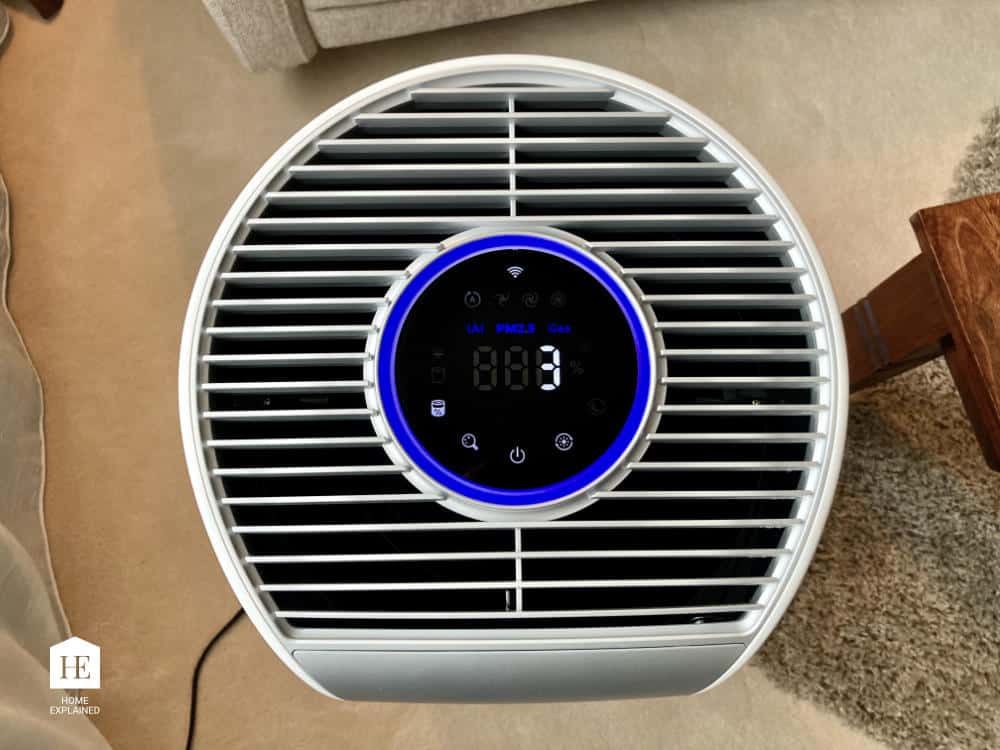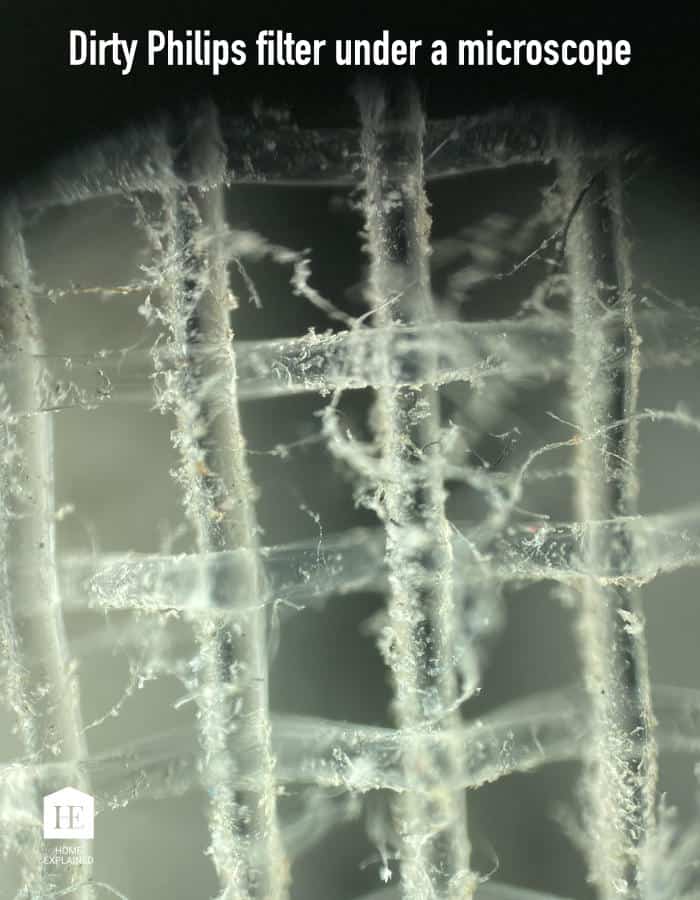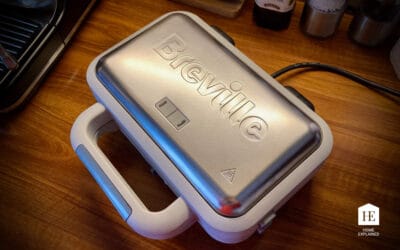Regardless of your final choice, we hope you’ll gain greater clarity about the most important aspects and things to look for when choosing the right air purifier for your home.
How Did We Choose the Air Purifier?
Before jumping into the review, we think it is important to briefly explain the process of choosing the Air Purifier, what criteria we used, and their respective importance.
The following list includes criteria we’ve found important when choosing an air purifier. They are listed from the ones we found the most important to the least. If you are interested in specific criteria, click the related link to skip to the relevant section.
Our list of criteria for choosing an air purifier:
- Air Filtration Efficiency and Performance
- Ease of Use
- Noise
- Smartphone App
- Price and Operating Costs
- Design
Conclusion: Is the Philips 3000i air purifier worth it?
Other Related Questions
– Philips air purifier 2000i vs 3000i vs 4000i comparison
– Do Philips air purifiers cool the air in the room?
– How long does it take the Philips 3000i to filter the air in the room?
1. Philips 3000i Review – Air Filtration Efficiency and Performance
Reasons for purchasing an air purifier are centered around our health; this is why we consider the efficiency and performance of an air purifier as our key deciding factor. In the end, if the air purifier is not able to remove pollutants effectively, then it’s of no use.
Our requirements in this regard were:
1.1. Appropriate CADR (Clean Air Delivery Rate)
We considered the size of our apartment (100 m) and picked an air purifier with a CADR appropriate or greater than recommended for the size of our room. A higher CADR value simply means that the air in the room will be filtered more often.
The Philips 3000i has a comparable CADR (520 m³/h) to Coway Air Mega 300S (509 m³/h) and BlueAir 211 (594 m³/h), our main contenders, and much higher than Dyson Purifier Cool Forlmadehyde (140 m³/h).
How does it work in practice?
What surprised us is that despite keeping our air purifier in one room (the most central one), the air quality in other rooms also improved. We do not necessarily attribute this to its ability to create powerful enough air circulation in a home but rather to an everyday human activity that affects the air movement in an apartment.
Although the CADR of 520 m³/h is enough for the size of our apartment, if I had to choose between Philips 3000i and Philips 4000i now, I would opt for Philips 4000i. The CADR of Philips 4000i is higher, which translates to faster air filtration, which is something a busy home with lots of cooking and daily activities can benefit from.
1.2. Effective Filtration of Dust and VOCs
We wanted a device that can filter out both small and large particles as well as volatile organic compounds (VOCs) like formaldehyde.
1.2.1 True HEPA Filter for Dust Filtration
Similarly to other popular air purifiers from brands such as Dyson, Coway, or Blueair, Philips 3000i also uses True HEPA filter technology to filter dust particles and even certain viruses. However, Philips claims their special NanoProtect HEPA filter can clean up to 2x more air than traditional HEPA H13.
All the above brands boast about their 99,99% filter efficiency, so there is not much difference in this regard.
Like most other brands, Phillips also includes a pre-filter to capture large dust particles that must be cleaned periodically.
How does it work in practice?
From our experience, Philips 3000i does an excellent job when it comes to dust filtration. We’ve been using the device for over three months in our ~1000 square feet apartment and see a noticeable reduction in dust accumulation (approx. 50% less). Of course, this is not supposed to substitute for regular vacuuming but simply shows Philips 3000i’s effective filtration.
More importantly, it removes tiny PM2.5 particles which can’t be seen with the naked eye but pose a more serious health risk.
1.2.2 Active Carbon Filter for VOC Filtration
Many household items, such as furniture, carpets, and paint, can emit Volatile Organic Compounds (VOCs), which can have a negative effect on our health. This is why an active carbon filter is a must-have feature in an air purifier. The good news is that most major brands nowadays use activated carbon filters.
How does it work in practice?
We were surprised at the sensitivity of the gas sensor Philips 3000i has. Even a few short sprays of hairspray (which contain large amounts of VOCs) in a different room ~30 feet away from Philips 3000i have been detected after a few minutes.
Regarding the effectiveness of the Philips 3000i, when it comes to VOC filtration, we can’t measure that directly. But since they are being picked up correctly by the Philips’ gas sensor, and after a while, the VOC values return to normal, we assume Philips 3000i does its job as expected.
1.3. Zero Ozone Emission
Even though certain ozone levels are considered safe, our preference was to go with an ozone-free air purifier. Since we were buying a health-related product, we didn’t want to take any risks.
Unlike some of its competitors, Philips 3000i doesn’t use an ionizer, thus ensuring no ozone emission. In comparison, the popular BlueAir 211 uses an ionizer, which was one of the reasons we looked elsewhere. The often recommended Coway Airmega Ap-1512hh also has an ionizer but with an option to turn it off when needed. The higher models, such as Coways Airmega 300s and 400s, as well as Dysons air Purifiers, don’t use an ionizer either.
1.4. Precise Sensors
One of the most impressive features we find on the Philips 3000i are its precise sensors. The air purifier has two sensors, one for detecting airborne particles and the other for measuring VOCs. When set in auto mode, the air purifier will increase or decrease the cleaning performance automatically based on the current levels of pollutants in the air.
As mentioned earlier, the gas sensor of the Philips 3000i was able to detect even a few short sprays of hairspray in another room dozens of feet away.
The particle sensor is also very sensitive. You can notice that everyday activities such as cooking, housework, or even movement in a room will increase the levels of PM2.5 particles detected by Philips 3000i.
As far as responsiveness goes, we find it to be really good. It will pick up any changes in air quality in seconds or minutes, depending on the airflow in the room.
While it is not common in air purifiers, it would be nice if Philips included a CO sensor with an alarm as well. This would add an extra layer of protection against another possible health hazard in your home.
2. Ease of Use
Once set up, the Philips 3000i is more of a set-it-and-forget-it type of device. It will clean the air automatically unless you choose one of its four manual settings (low, medium, turbo, and sleep mode). In our experience, it’s best to keep it on auto mode and let it do its job. For the most part, it won’t require any further attention except for vacuuming the filter. This has to be done every couple of weeks when the top display shows the clean filter prompt, and it shouldn’t take more than a few minutes.
The filter has to be replaced every 3 years, the longest period we have seen on an air purifier. Compared to brands such as Dyson or Coway, the recommended exchange period is 12 months. For Blueair, it’s even shorter at 6 months. This positively affects overall operating costs, but more on that later.
Should we have mentioned one disadvantage, it would be oversimplified and insufficient instructions that Philips provides for the initial setup and use of the device. Don’t get me wrong, setting up this air purifier is a simple process, but the provided instructions leave a lot of room for questions.
Also, updating the firmware on the Philips 3000i via the Air+ app was a bit cumbersome. During the time we had Philips 3000i, there were two firmware updates. The first time it was confusing as to whether the firmware was being updated or not. And the second time, it didn’t start the update despite following the instructions. Thankfully, the update was installed automatically in the following days, but that’s something Philips should improve in the future.
3. Noise
For those who want to use their air purifier continuously, especially at night, the noise level of the device should be considered.
When in a standard mode, most purifiers we looked at (Dyson TP09, Airmega Ap-1512hh, Blueair 211) are pretty similar, ranging from the low 30s to the low 60s dB for the highest setting. The loudest of the bunch is the Dyson.
Philips Dual Scan Series 3000i also falls in this range with a noise level ranging from 34-56 dB depending on the mode and fan speed. In auto mode, the noise level is usually around 34 dB, which is whisper-quiet and barely noticeable.
More importantly, if you want to keep your air purifier on at night, Philips is the clear winner being the quietest of the four. In sleep mode, Philips can run at an impressively low noise level of just 15 dB, which means it basically becomes inaudible. We literally couldn’t tell whether it was running sleeping 6 feet away from the device.
4. Smartphone App – Philips Air+
A good smartphone app should be, in our opinion, an essential part of any modern air purifier.
The Philips Air+ app allows you to monitor air quality in your home, adjust different filtering modes, set cleaning schedules, and keep track of filter status, among others.
Overall we really like the app. It’s easy to use, has all the features you would expect from an air purifier app, and works reliably. Compared with apps of other brands such as Dyson and Blueair, they all offer similar features and surprisingly even share a very similar 4.6-star rating on the Appstore. The only poorly rated app is Coway IoCare, which many users report is not working at all. This was one of the main reasons we decided to avoid the Coway air purifier, as having a decent smartphone app is a must for us.
Screenshots of some of the features of the Philips Air+ app (from right to left): Historical data charts of different air pollutants (2.5.PM, Gas/VOC, Allergens), filter status, current air condition, and controls.
5. Price and Operating Costs
Depending on where in the world you buy Philips 3000i (Amazon link), the price tag will vary. For example, in Australia, prices range from around $650 to over $750. When compared with the earlier mentioned brands, Philips is the most affordable of them all.
For a better comparison, we’ve created a table below showing the initial cost, the cost of exchange filters, and their expected lifetime.
| Model | Purifier Price | Filter Price | Filter Lifetime |
| Philips | $650 | $130 | 36 months |
| Dyson | $999 | $99 | 12 months |
| Blue 3610 | $929 | $140 | 6 months |
| Coway 300 | $849 | $140 | 12 months |
5.1. Energy Consumption
An air purifier is a device that will run in many homes 24/7. This is why we decided to look at its energy consumption. For one week, we measured the energy consumption in our home. The goal was to determine how much the Philips 3000i consumes in a typical home environment, where everyday activities such as cooking, cleaning, and other household chores occur. For the whole week, the air purifier was scheduled to run in auto mode from 6:30 am to 10:30 pm and in sleep mode from 10:30 pm to 6:30 am.
As you can see from the screenshot, the Philips 3000i consumed only 1.06 kWh of electricity for the entire week, which is very low. With an average electricity rate of $0.25 per kWh, Philips 3000i will cost you only around $13 to run it 24/7 all year long.

6. Design
While the design is largely subjective and certainly not the most important factor when looking for an air purifier, we personally like its sleek look. There are multiple Phillips 3000i design variations that you can choose from, and despite differing slightly in terms of looks, they all have the same features and performance.
The Philips 3000i features a touch-sensitive top panel that controls different settings. The top display gives you all the information you need, including real-time air quality stats in three categories – allergens, PM2.5, and gas. The led ring around the display changes its color according to the room’s current air quality, giving you a clear visual representation of the air even from a distance. The led display is also light-sensitive and adjusts its intensity or turns off based on the light levels in the room. If you prefer to save a bit of extra energy, you can turn it off manually.

Conclusion: Is the Philips 3000i Air Purifier Worth It?
In our opinion, the Philips 3000i is amongst the very best air purifiers in its price range. It’s affordable but doesn’t compromise on features or performance. Thanks to its NanoProtect HEPA, in combination with a charcoal filter, and respectable CADR of 520 m³/h, you can rest assured that it will make the air in your home pristine. On top of that, Philips doesn’t use an ionizer, which means zero ozone emission.
The Philips 3000i also has a low energy consumption (only 1.06 kWh per week) which translates to around $13 a year in energy costs. Additionally, it is also the quietest air purifier we found. With a 15db noise level in sleep mode, it’s basically inaudible.
Maintenance of the filters is pretty straightforward, and Philips recommends replacing them every 36 months, which is also the longest period we’ve seen among air purifiers. This has obvious positive implications for both the environment and your wallet.
There are very few things to complain about the Philips 3000i. The biggest downside is the rather poor instructions manual that Philips has included and a somewhat cumbersome process of updating the firmware. Other than that, the Philips Air+ app is easy to use and has all the features and stats you need.
After 3 months of continuous use, we can honestly say that the Philips 3000i was a well-worth purchase and can highly recommend it to anyone looking for an air purifier.
Other Related Questions
Philips Air Purifier 2000i vs 3000i vs 4000i Comparison
The main difference between these models is their CADR rating. In other words, they differ in the amount of clean air a particular model can deliver per hour. Philips 2000i has a CADR rating of 333 m³/h, Philips 3000i has a rating of 520 m³/h, and Philips 4000i has the highest rating of 610 m³/h.
Aside from the CADR rating, they also differ in size, look, and price, but that’s to be expected.
Do Philips Air Purifiers Cool the Air in the Room?
No, Philips air purifiers do not cool the air in the room. The breeze they produce might give you the impression of air cooling, but Philips air purifiers don’t actually impact the air temperature in any way.
How Long Does it Take the Philips 3000i to Filter the Air in the Room?
The Philips 3000i air purifier has a CADR rating of 520 m³/h, meaning it can filter the air in an average room of 220 ft² (20 m²) in around 6 minutes.












0 Comments